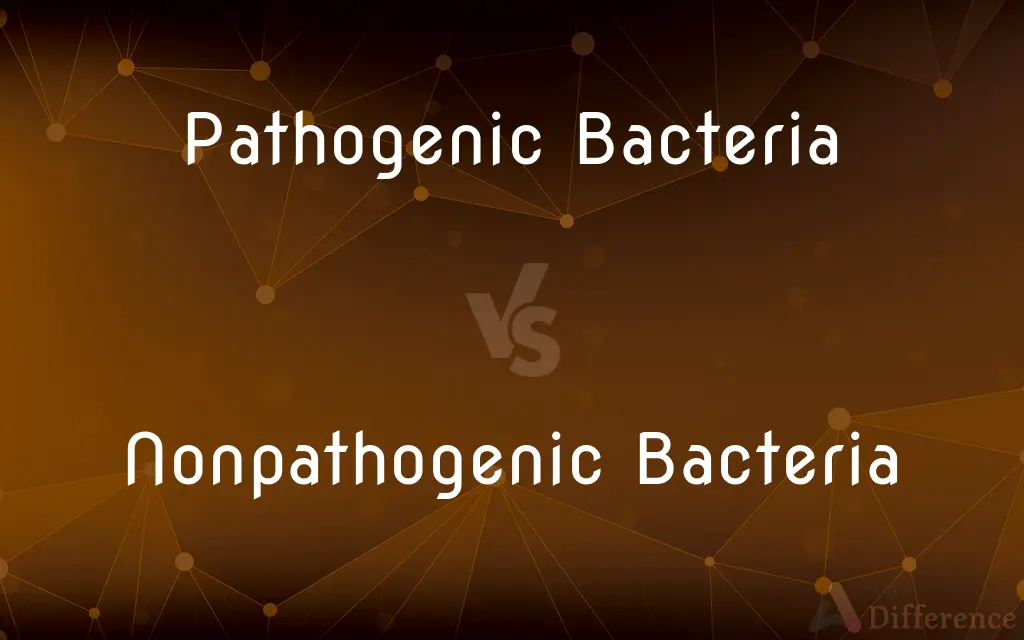Pathogenic Bacteria vs. Nonpathogenic Bacteria — What's the Difference?
Edited by Tayyaba Rehman — By Fiza Rafique — Published on December 1, 2023
Pathogenic Bacteria cause diseases in hosts, while Nonpathogenic Bacteria are generally harmless and can even be beneficial.

Difference Between Pathogenic Bacteria and Nonpathogenic Bacteria
Table of Contents
ADVERTISEMENT
Key Differences
Pathogenic Bacteria are microorganisms that have the ability to cause diseases, infections, or illnesses in hosts. Nonpathogenic Bacteria, in contrast, don't cause diseases but instead often exist harmoniously within environments or organisms.
While Pathogenic Bacteria can lead to a range of ailments from minor infections to life-threatening conditions, Nonpathogenic Bacteria may play essential roles in processes such as digestion and nutrient cycling.
Pathogenic Bacteria often possess unique structures or toxins that allow them to invade and damage host tissues. Nonpathogenic Bacteria generally lack these aggressive characteristics and might even compete with harmful bacteria, offering protective effects.
In medical and research contexts, it's crucial to identify and understand Pathogenic Bacteria to prevent or treat the diseases they cause. Recognizing Nonpathogenic Bacteria is equally vital, especially when harnessing them for beneficial purposes, like in probiotics.
Both Pathogenic and Nonpathogenic Bacteria have vital roles in ecosystems. While the former can disrupt and cause imbalances, the latter often contributes to stability, symbiotic relationships, and overall health of environments and organisms.
ADVERTISEMENT
Comparison Chart
Disease Causation
Causes diseases in hosts
Does not cause diseases
Common Habitats
Can be found in contaminated areas, hosts
Commonly found in natural environments, hosts
Role in the Body
Can invade and damage tissues
Often beneficial; e.g., aiding in digestion
Use in Industries
Studied for disease treatment
Used in food industry, waste treatment, etc.
Interaction with Host
Often harmful
Can be neutral or beneficial
Compare with Definitions
Pathogenic Bacteria
Microorganisms capable of invading host tissues.
Pathogenic Bacteria, like Streptococcus pyogenes, can lead to strep throat in humans.
Nonpathogenic Bacteria
Bacteria beneficial to human health and environment.
Probiotics contain Nonpathogenic Bacteria that promote a healthy digestive system.
Pathogenic Bacteria
Bacteria possessing virulence factors aiding in disease causation.
Some Pathogenic Bacteria produce toxins that damage host cells.
Nonpathogenic Bacteria
Bacteria that don't cause disease.
Most of the bacteria in the human gut are Nonpathogenic Bacteria that aid in digestion.
Pathogenic Bacteria
Bacteria that can disrupt the normal balance in organisms.
Pathogenic Bacteria in contaminated water can lead to gastrointestinal infections.
Nonpathogenic Bacteria
Microorganisms that can outcompete harmful bacteria in some environments.
Introducing Nonpathogenic Bacteria in water can sometimes help reduce the number of pathogens.
Pathogenic Bacteria
Disease-causing agents requiring careful handling in laboratories.
Researchers take precautions when working with Pathogenic Bacteria to prevent contamination.
Nonpathogenic Bacteria
Bacteria lacking virulence factors for disease causation.
Nonpathogenic Bacteria strains are often used in lab experiments without posing a health risk.
Pathogenic Bacteria
Bacteria that can cause disease in organisms.
Tuberculosis is caused by a specific Pathogenic Bacteria called Mycobacterium tuberculosis.
Nonpathogenic Bacteria
Generally harmless microorganisms often found in nature.
Nonpathogenic Bacteria in soil help break down organic matter.
Common Curiosities
How can one protect against Pathogenic Bacteria?
Maintaining hygiene, cooking food properly, and getting vaccinated can protect against many Pathogenic Bacteria.
Are all Nonpathogenic Bacteria beneficial?
While many Nonpathogenic Bacteria are beneficial, some are simply neutral and don't impact hosts.
Do Nonpathogenic Bacteria cause any infections?
Typically, Nonpathogenic Bacteria don't cause infections, though some might under specific conditions.
What are Pathogenic Bacteria?
Pathogenic Bacteria are microorganisms that can cause diseases or infections in hosts.
What are Nonpathogenic Bacteria?
Nonpathogenic Bacteria are generally harmless bacteria that don't cause diseases.
Why is it essential to study Pathogenic Bacteria?
Studying Pathogenic Bacteria helps in disease prevention, treatment, and understanding microbial evolution.
Can Pathogenic Bacteria be found in food?
Yes, some foods can be contaminated with Pathogenic Bacteria, leading to foodborne illnesses.
How do Pathogenic Bacteria enter the body?
Pathogenic Bacteria can enter through ingestion, inhalation, open wounds, or contact with contaminated surfaces.
Can Pathogenic Bacteria be treated?
Many Pathogenic Bacteria can be treated with antibiotics, though resistance is a growing concern.
Do Pathogenic Bacteria always cause severe diseases?
While some Pathogenic Bacteria can cause severe diseases, others may lead to milder infections.
Can Nonpathogenic Bacteria benefit the environment?
Yes, Nonpathogenic Bacteria play roles in nutrient cycling, decomposition, and soil health.
Are probiotics a type of Nonpathogenic Bacteria?
Yes, probiotics contain beneficial Nonpathogenic Bacteria that support gut health.
Can Nonpathogenic Bacteria become pathogenic?
Rarely, certain conditions or genetic changes might make Nonpathogenic Bacteria pathogenic.
How are Nonpathogenic Bacteria useful in industries?
Nonpathogenic Bacteria are used in food production, waste treatment, bioremediation, and more.
Are Pathogenic Bacteria present everywhere?
Pathogenic Bacteria are widespread, but hygiene and public health measures limit their spread in many areas.
Share Your Discovery

Previous Comparison
Oak Wood vs. Teak Wood
Next Comparison
5’9 vs. 5’10Author Spotlight
Written by
Fiza RafiqueFiza Rafique is a skilled content writer at AskDifference.com, where she meticulously refines and enhances written pieces. Drawing from her vast editorial expertise, Fiza ensures clarity, accuracy, and precision in every article. Passionate about language, she continually seeks to elevate the quality of content for readers worldwide.
Edited by
Tayyaba RehmanTayyaba Rehman is a distinguished writer, currently serving as a primary contributor to askdifference.com. As a researcher in semantics and etymology, Tayyaba's passion for the complexity of languages and their distinctions has found a perfect home on the platform. Tayyaba delves into the intricacies of language, distinguishing between commonly confused words and phrases, thereby providing clarity for readers worldwide.
















































